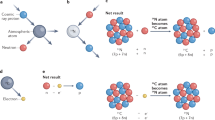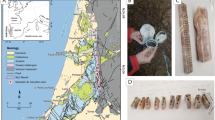Abstract
THE potentialities of radioactive methods of determining the ages of rocks, minerals and meteorites are so great that much time, money and effort have been expended in age research during the past decade. The supplement to the chemical method of the more elegant physical method of lead age determination from isotopic abundances has done much to establish confidence in the lead time–scale; but more hope has been held for the helium method because of its promised application to a great variety of geological materials rather than to a limited group of rare minerals.
This is a preview of subscription content, access via your institution
Access options
Subscribe to this journal
Receive 51 print issues and online access
$199.00 per year
only $3.90 per issue
Buy this article
- Purchase on Springer Link
- Instant access to full article PDF
Prices may be subject to local taxes which are calculated during checkout
Similar content being viewed by others
References
Keevil, N. B., Amer. J. Sci., 36, 406–16 (1938); see NATURE, 143, 32 (1939).
Hurley, P. M., and Goodman, C., Bull. Geol. Soc. Amer., 52, 545–60 (1941).
Author information
Authors and Affiliations
Rights and permissions
About this article
Cite this article
KEEVIL, N. THE HELIUM METHOD FOR DETERMINING THE AGE OF ROCKS. Nature 148, 445–446 (1941). https://doi.org/10.1038/148445a0
Issue Date:
DOI: https://doi.org/10.1038/148445a0
Comments
By submitting a comment you agree to abide by our Terms and Community Guidelines. If you find something abusive or that does not comply with our terms or guidelines please flag it as inappropriate.



